LUKE THURGATE – The Burra Archive – Residency

THE BURRA ARCHIVE – LUKE THURGATE RESIDENCY
Drawing on Walls: 20 November to 1 December
Ten days of artist-in-action charcoal renderings in the Main Gallery.
We’re invited to watch and chat to him about the work.
Luke is asking us to contribute small items of personal significance (not photos) to include in his big drawing on the walls of Burra Gallery.
To register your interest phone the gallery on 8892 2411, or just drop in with your object, which will be labelled for safekeeping.
Masterclass – a workshop opportunity for artists to create big drawings on paper.
10am to 4.30pm Saturday 24 November. 10 participants, cost $50. Materials supplied.
Exhibition opening and artist talk 5.30pm Saturday 1 December.
The exhibition finishes Sunday December 23, and will include Masterclass works for sale.
About Luke …
Luke Thurgate draws from way back. He is also a sophisticated educator, administrator and tutor at Adelaide Central Art School. The 10-day project The Burra Archive in Burra Gallery will need the creative and physical powers of a caveman of Altamira. Perhaps Burra Gallery will make the job easier by providing Luke with management and support in his role of draughtsman, artisan and creator. We appreciate that the quality he gifts to our community is a rare thing. We are excited and intrigued and can’t wait to see. We are also shocked at the idea of something forbidden – it must be very special to be allowed!
What we can do to help …
We can bring small items for inclusion in the drawing, to arouse Luke’s curiosity. He wants to know the story of each one. We will see him transform our humble offerings into something with context and meaning, perhaps beyond our understanding. Art will be born from the simplest input from local people – our stories.
Burra Gallery portrait prizes and SALA exhibitions have attempted this feat. Identity is a fragile concept in the Mid North of SA. It’s easier not to think about, keep it quiet, toe the line. Now the line has come to us, in the form of Luke Thurgate’s The Burra Archive. He finds us interesting, and even loveable. He is a country boy. He feels at home in the regions. That’s why he can throw himself on the mercy of a small town with an art gallery, staffed by volunteers drawn from the local community. Is this the start of something or is it a continuation of what’s gone before? We know we’re onto something. But what exactly is it?
The Big Picture
This project seeks to connect a small town in regional South Australia to what’s going on in Adelaide and beyond. How will meaning be derived from a collection of 50 to 100 small items stirred into uniquely mysterious imagery that will surprise even the man with charcoal in his hand?

Luke Thurgate ‘Dead Bird Rub Out’ 2014 charcoal on wall
Day 1 Tuesday
In the quiet of a shared space – Kerry at the desk and Luke drawing on the wall, I’m writing this while flying in thought out the window to Burra creek and hills. A red spot on a distant pine has taken my attention, glowing against the hill. Luke’s drawing begins to emerge on the pristine wall of Burra Gallery. I’m interested to see how the drawing relates to this morning’s class of Burra Community School’s year 8 and 9s.


Introduction to drawing with charcoal
What charcoal is.
All artists feel anxiety when starting a drawing.
Make an ant line. Consider size, weight, speed and direction. 1 minute.
Make a fly line. 10 seconds.
Hold the charcoal on the side.
Make a kangaroo line. 10 seconds.
Turn the paper over.
Make an elephant line. 10 seconds.
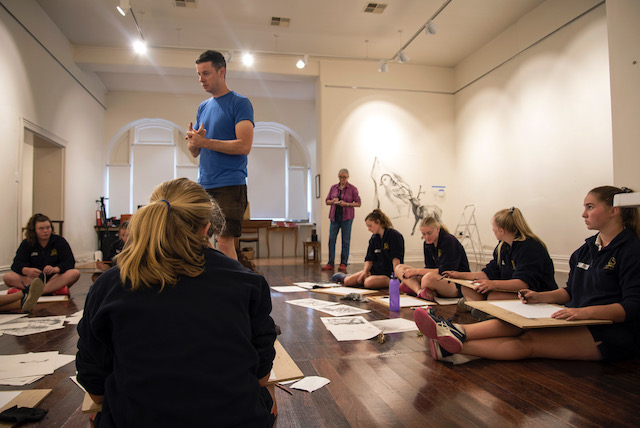

Object
Here we find ways to bypass the controlling brain.
Collect an object from the garden.
Look at the object and draw, using one uninterrupted line with reference to the ant, noting speed, direction and weight.
Describe the object in 3 words. Close your eyes. Imagine an object relating to that description.
Consider an object, for example a fork, and imagine what else it could be, given its shape.
Fresh paper. With charcoal make a smooth surface block and draw with eraser, noting planes of the object (where light falls). 3 minutes.
Use white chalk to highlight. Fill the area.

Social capacity of art
For The Burra Archive, objects will be loaned by Burra residents, involving us all in Luke’s drawing.
To make art, we depend on each other in many ways – as in collaborations in theatre and sport.
Learning to work together makes us better.
Partners –
The “seeing” partner leads and describes, while the “blind” one draws and follows. 5 minutes. Swap.
With drawing hands tied together, talk with each other about resting, and about leading and following. 5 minutes.
draw to the right a little bit ….make a really thin straight line….stop….move back to the left….press harder….
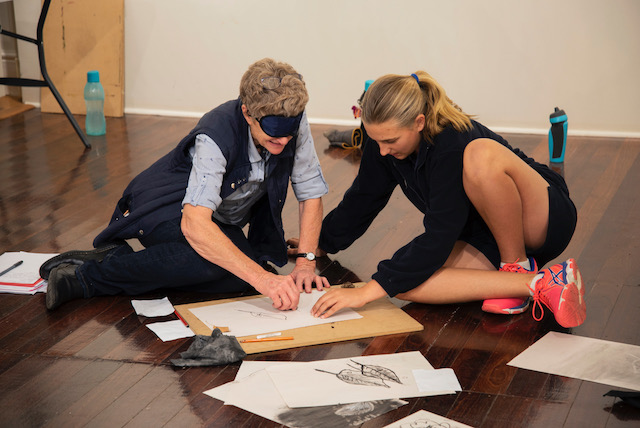
Then
Make a new drawing on better paper, use whole sheet. Think about where to place the object.
Use previously learned techniques. Assume the first marks will be wrong. Build detail last.
We’re away!
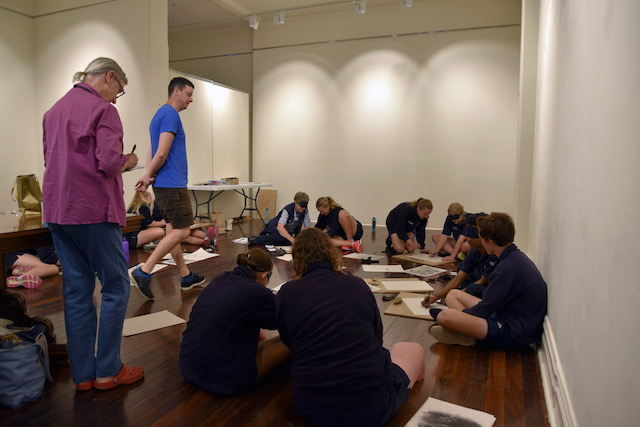
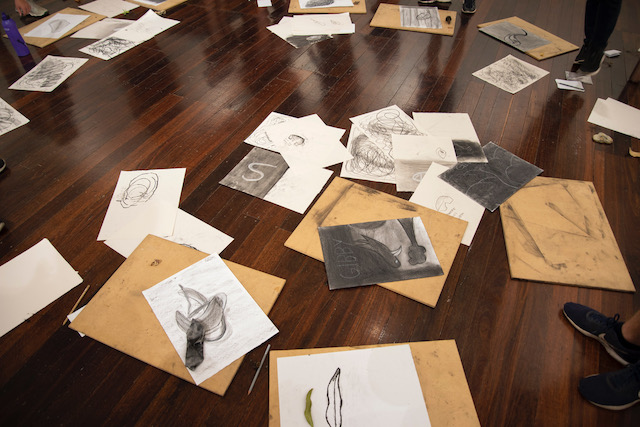
Day 2 Wednesday
Outside / inside
I see the big wall drawing beside the window, with the view of trees moved by wind and rain on this grey day.
The knitted rabbit looks less than pleased.

Workshop
Today students from Eudunda Area School Years 9 and 10 come for Luke’s workshop. The divergent thinking exercise with the fork brings forth answers like musical instrument, plough, comb and prop.
Imagination helps develop ideas and is an essential part of your art practice.
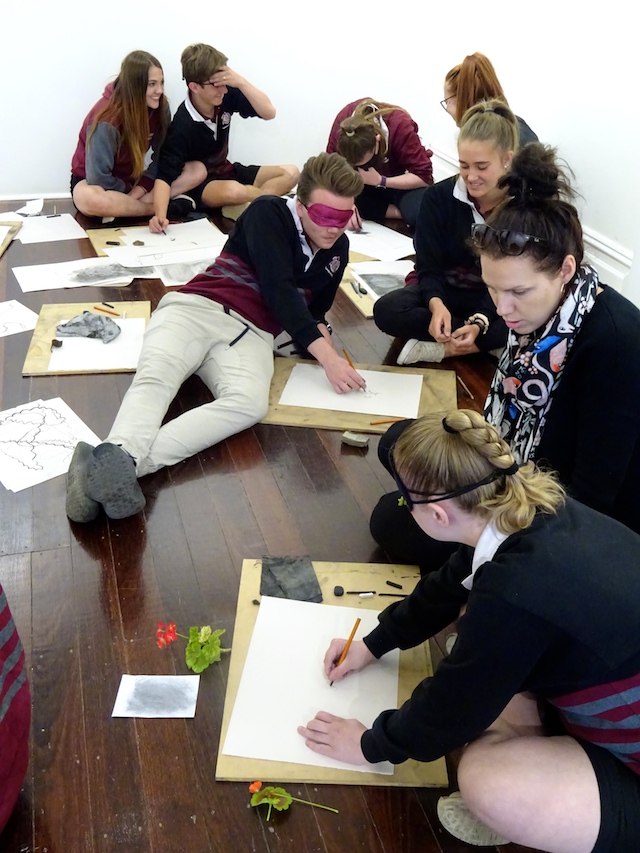
Students use basic drawing equipment – willow and compressed charcoal, white pastel, eraser, cloth for dusting off and charcoal pencil – and understand when Luke says that process comes before results. Materials used in different ways are like words in a vocabulary, intensified by the connection between quality of line and imagination.
“Laying a ground” consists of dusting back to an even flat charcoal surface. Students make a drawing using an eraser and white pastel.
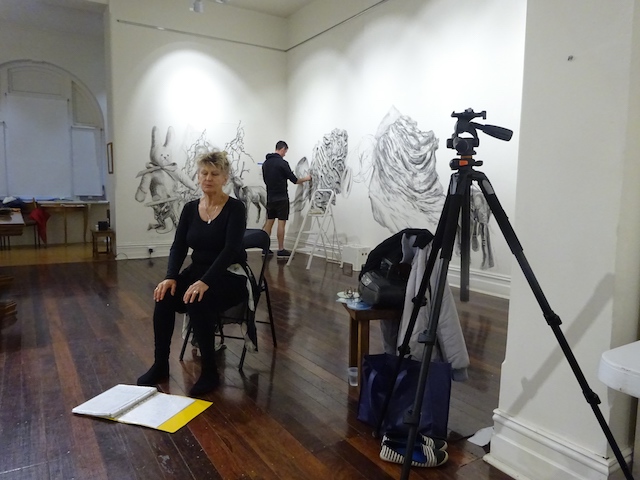
Exercise class
Luke works on through the evening’s exercise class, incorporating a new object in the corner between two parts of the drawing.

During the evening discussion about what’s happening in the gallery a boy asks about one of the objects. Luke explains the architectural qualities of a wasp nest, its complex structure scaled up on the wall during the day.
The dynamic relationship between object and size accentuates the fine line between connections and impending collision. Uncertainty of direction is paramount.

Day 3 Thursday
Body Language
Today’s a conversation – in more ways than one. We talk about divergence – starting with one idea and turning it into multiple ideas. Burra Community School’s Year 9 and 10 came straight in from swimming, and it’s a cold day. In uses for a fork the most original answer was a DIY wave splitter and others were pretty good too. Luke moved around the room, transfixing students with new ways of thinking, for instance training the mind for creativity like an athlete trains the body – both extending the potential of what is possible.
A piece of willow or natural charcoal has a core and places where twigs once branched. It is light in weight and soft in texture while condensed charcoal, with clay added to ground pigment, is dark and heavy.
Students of drawing develop confidence and overcome anxiety, knowing that making corrections is a simple matter – just brush it off! Luke draws a heavy black line on the wall to demonstrate. The point is made when he brushes it off and with a few strokes brings it in to the rest of the drawing.
Lesson: don’t be afraid of your materials.
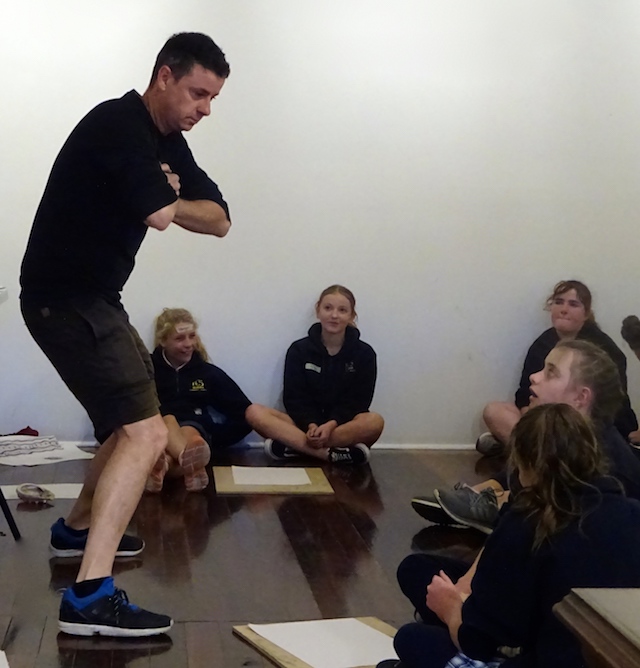

Local contributions
Our neighbour takes an interest, and books in for the Masterclass. She has never drawn before but is open to having a go. Luke explains what he’s doing as a project in social engagement – through art experiencing others’ stories.
This project brings in many aspects of art and community. It has been in the planning for nearly 2 years yet only lasts for 2 weeks. The work will be viewable until December 23. After Christmas and before the next exhibition, starting February 14, the walls will be cleaned and repainted.
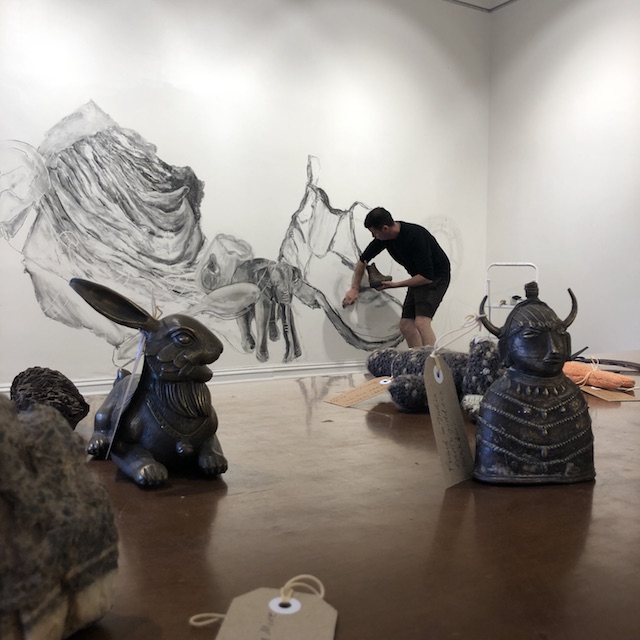
What’s going on
Our group of volunteers and local residents are excited at the prospect of a big drawing and have marked the date to attend the launch. On my walk round Burra today I found many who still do not know what’s going on in the gallery. Yet we work hard to publicise.
Please let there be no-one who says, after the launch at 5.30pm Saturday December 1st, that they are sorry to have missed the opportunity of meeting Luke and contributing an object for the drawing.
Day 4 Friday
Drawing outside of school
Today’s workshop is with children of Booborowie Primary School, years 5 to 7.
These photos show what the students can do.
Some of them already know the things to look for in a drawing and they ask some very good questions.

Luke explains how shading is done to give depth to the drawing and introduces children to the words mnemonic device. They get it straight away and one boy says “is that like putting a string round your finger?” The objects brought in by Burra residents are reminders of the past and all have a story, some are known and some are not.
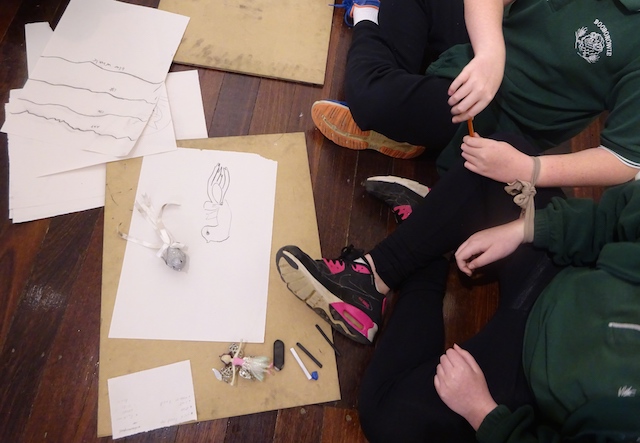
The students draw in pairs blindfold and with hands tied together, after choosing objects from the garden. The little fairy in this photo comes from the special garden made by the grandchildren of one of the gallery volunteers. They will be happy to see it in the photo, and maybe one day it will be a mnemonic device for them.
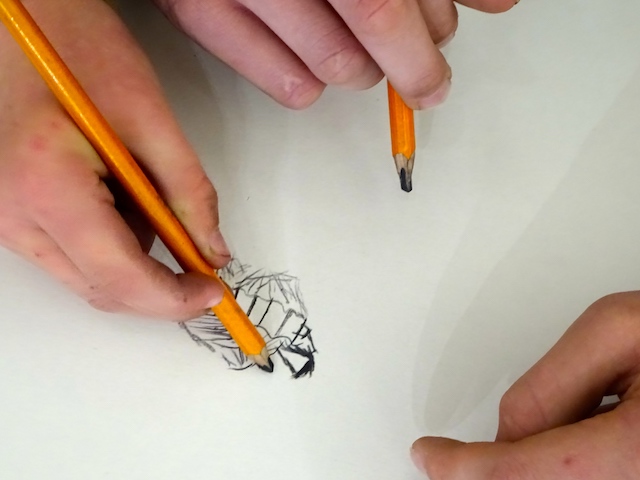
These charcoal pencils are a good tool for drawing. Luke sharpens them using a blade, never a pencil sharpener. This photo of students making a collaborative drawing shows two different ways of holding a pencil. It also illustrates how fearless the children are in their mark making.
Afternoon
The big drawing progresses this afternoon with the addition of a strange object in the corner. When it came in we wondered at its shape and age, but nobody knows for sure. Bought locally at a garage sale by a friend who loves the shape and design of art deco, it is about twenty centimetres in height and must once have had a glass insert.
Day 5 Saturday
Masterclass – primary concerns
These images can be found in “Grey’s Anatomy” and show Luke’s student work carried out on wall and floor.
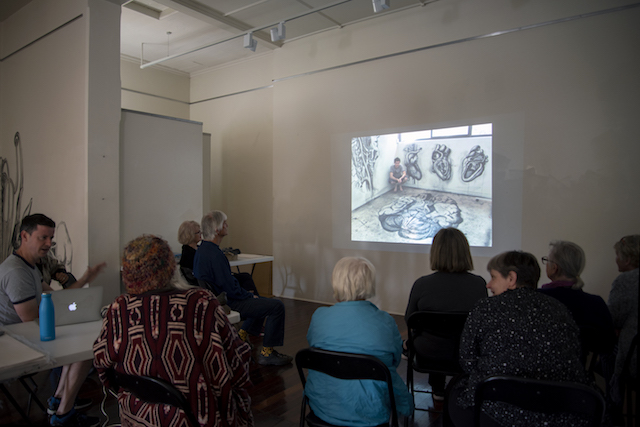
Luke’s idea of erasure originated from the assessment when his floor piece was obliterated by an over zealous cleaner. This was a lucky break for him, he says, because it made him realise why he was making big works on wall or floor. Erasure being a fact, process must be the priority. He taught this fact to us in Masterclass.
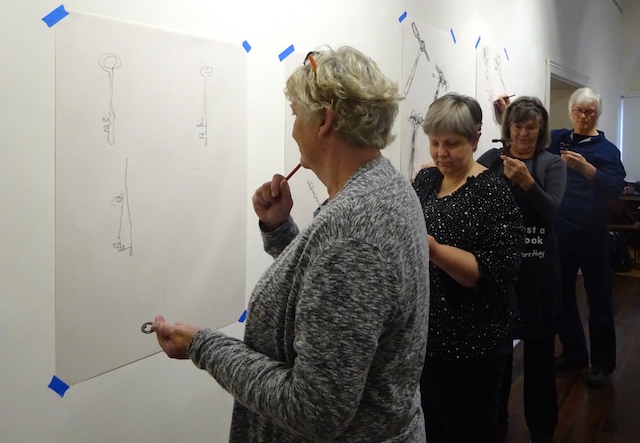
An object is drawn by students using techniques designed to bypass preconceptions. This drawing was made while looking at the object, not at the hand doing the drawing. We are surprised when we see what we have done. We challenge default ways of looking and seeing.
Some thoughts
How does this thing work? Look at the planes and understand the structure.
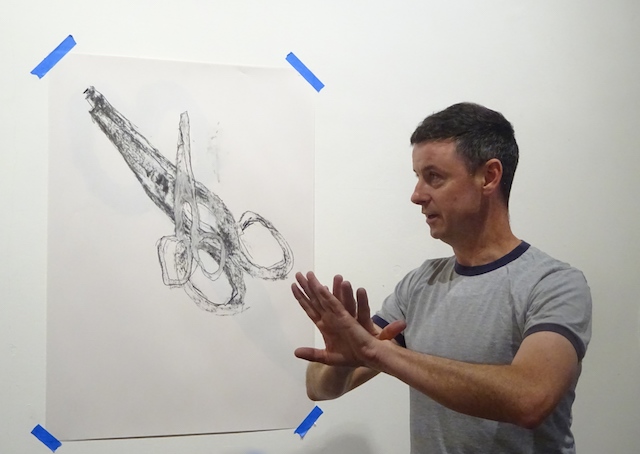
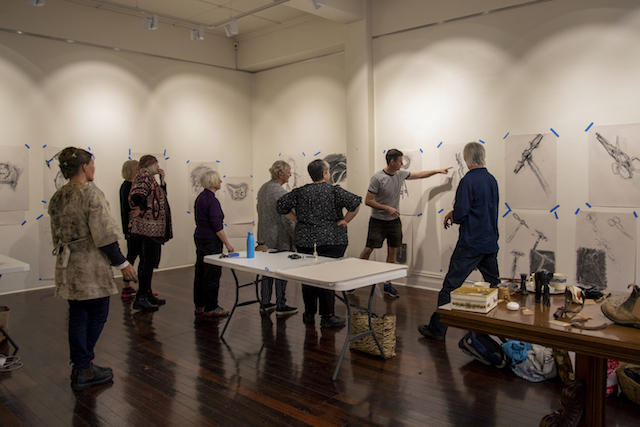
Charcoal can be held in different ways – holding the stick like chalk makes it easy to draw straight lines. The same applies to brushes.
Often we privilege creating a likeness over our own unique mark making.
We constantly edit the drawing and the traces demonstrate where we’re headed. Our speculations are part of the drawing.
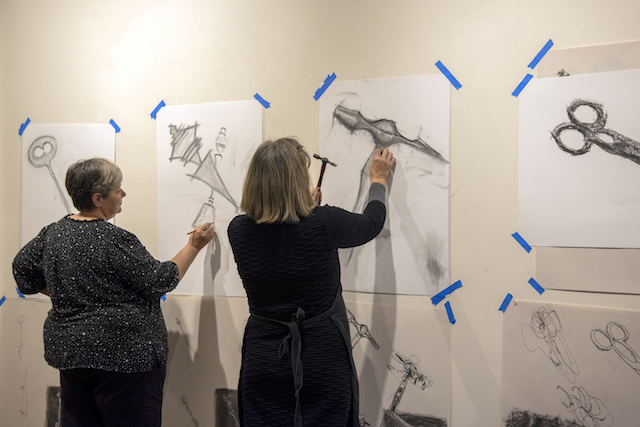
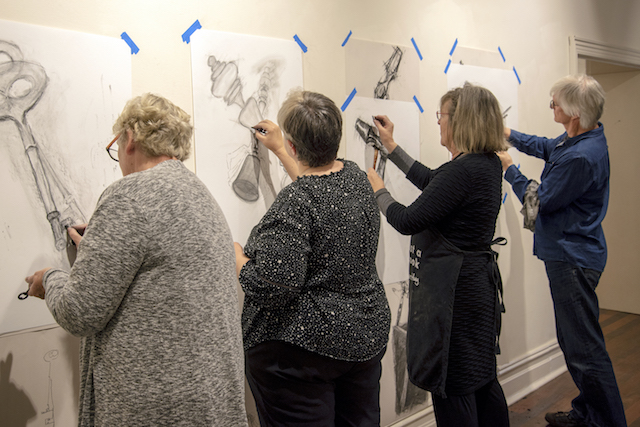


Day 8 Tuesday
The long view
Objects survive through luck rather than value; dregs from others’ lives, random bits and pieces imaged in Luke’s drawing. The choices he is making regarding placement are personal, but he is at the mercy of the choices we make in bringing the objects for him to include in the drawing..
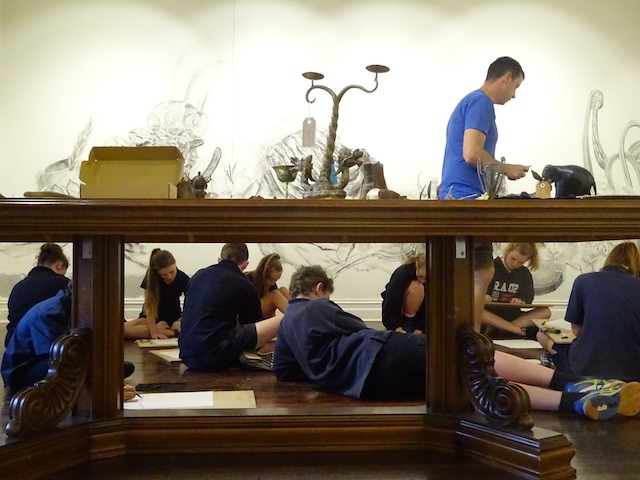
Education is important to Luke. He is all for young people exploring their ideas and, with wise teaching, going where curiosity takes them. Here is today’s Year 7 class of students from Burra Community School.
Luke intends to include every object in the drawing – quite a challenge with 4 days to go and objects still coming in. The selection of where to place objects is personal and Luke is amused that many fierce faces surround an innocent looking knitted rabbit. It may be that changes will be made. Watch this space or attend the launch on Saturday.
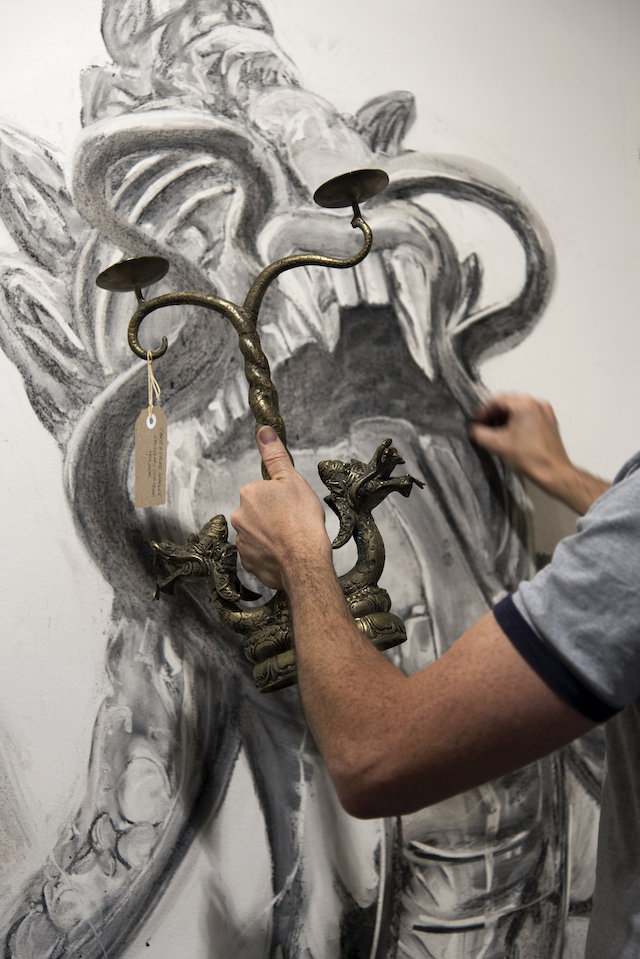
A dragon candlestick included in today’s drawing, purchased at one of Burra’s many antique and collectables shops.
Day 9 Wednesday
Luke has had a morning of relaxed concentration. The estimating brain ticking over:
how many objects still to include, how many still to come in?
Strange juxtapositions
1. Soldier and chess piece
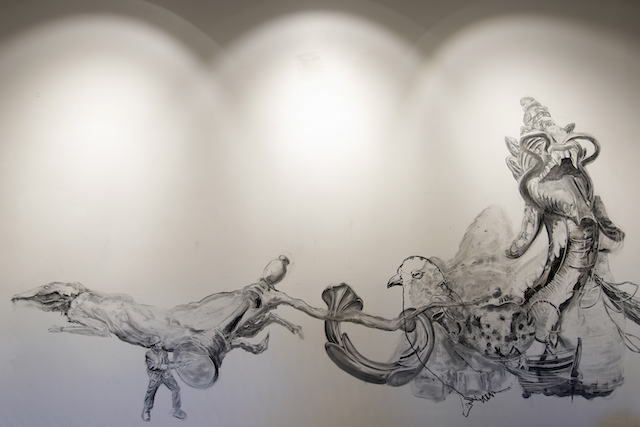
2. Teapot handle and rat’s tail
3. Scissors and knitted rabbit
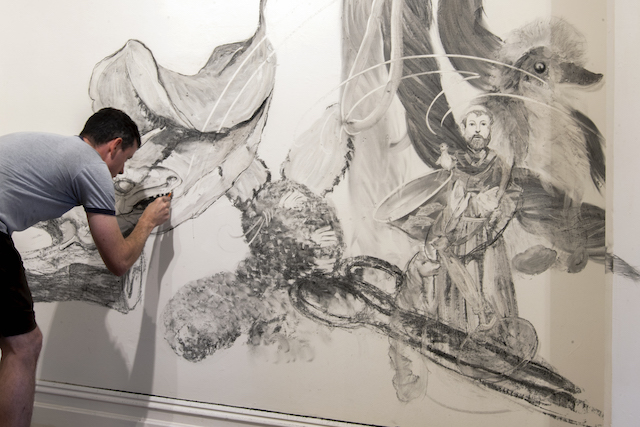
4. Soap holder and railway spike, with an angel playing an accordion overlapping an old boot.
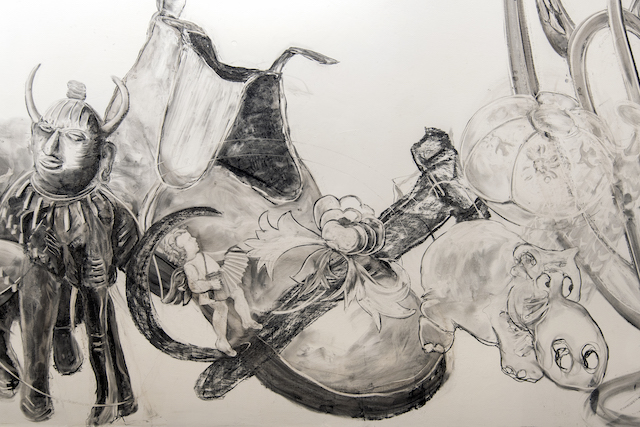
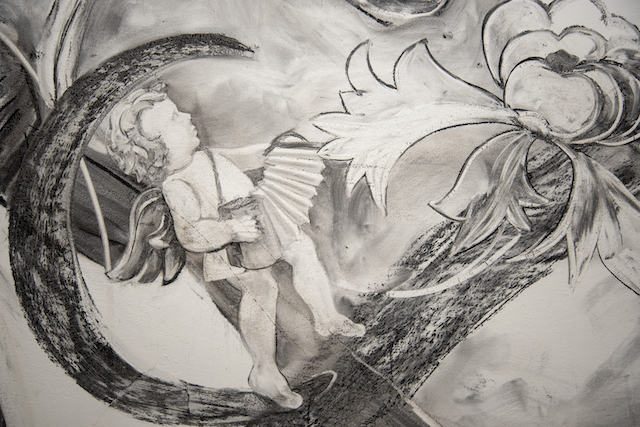
It’s usually “like” objects that are found together – a snail in its shell, a head with a hat or a baby shaking a rattle.
This makes me think of the student workshop when Luke asked the children to write down the uses for a fork.
The idea of a fork can lead to many answers, depending on the breadth of imagination.
Day 10 Thursday
Coalescence
Things are coming together, as all matter coalesces to form a unified whole. Today I see Luke working into the drawing to merge, fuse and blend objects, pushing some forward and others back, sharpening a line, smudging another, and using the eraser to great effect.
He says to the children “Who can see the elephant?”
The friend who brought in the little wooden horse finds it hiding in full view.
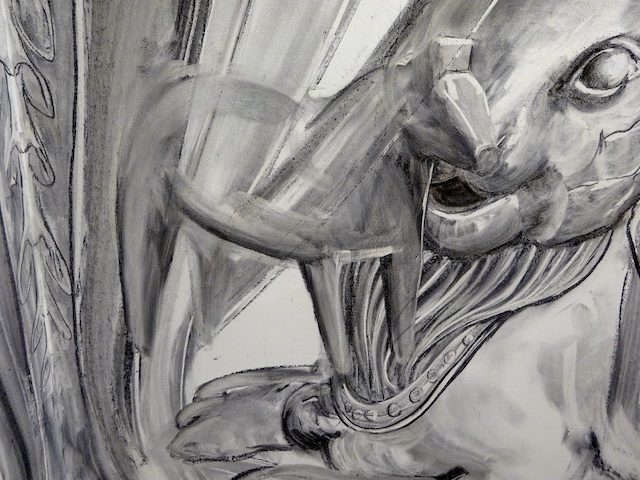
The camera, on its three long black spider legs, clicks away each afternoon. Creepy stuff is all around and it’s very exciting. Everyone is loving it. Visitors are glad they dropped by – traversing the continent from north to south and west to east in explorer fashion – calling in to Burra for sustenance: coffee and art.

The power of art
Each day a new group of children pays us a visit to see the drawing. Today they picked out an object for Luke to draw, and watched in fascination as it appeared on the wall. As they watch, Luke tells them interesting things about drawing.
There’s one more day to go and then it’s Saturday – winding down and finishing off ready for the exhibition launch.
Day 11 Friday
Location: Burra
Burra is a heritage town – hot and dry, on the Outback edge, chock-a-block with heritage buildings and old miners’ cottages. Life was tough in those old days, when people were advised to head north for work in the fabulous Burra Burra Monster Mine.
Back then Burra had a population of about 5,000 and many dug homes in the banks of the creek with their chimneys poking out of the ground above. Burra Creek is over the road from the gallery. Children from Burra Community School use the pedestrian bridge to come and see Luke’s drawing, and traces of what remains of the dugouts can still be found.

Descendants of the early settlers have their forebears to thank for the layout of the town, the buildings, the street names and many of the stories; some of the latter are reflected in objects in Luke’s drawing. The object below is called an “Ink kettle” and must have been used by one of the people who came to live here.

Choices
Why do we choose or do one thing in preference to another? Luke notices that some of us go to the object table first and then view the drawing, while others favour the drawing first. The process for many is to link objects with their representation in charcoal on the wall, but for others it’s the other way round.

Kerry is taking the time to sort objects into a rhythmic display on the table and place the smallest ones in a glass topped cabinet, a treasured object in its own right. You will see the drawing and the display when you come to visit Burra Gallery by the final day 23 December.

